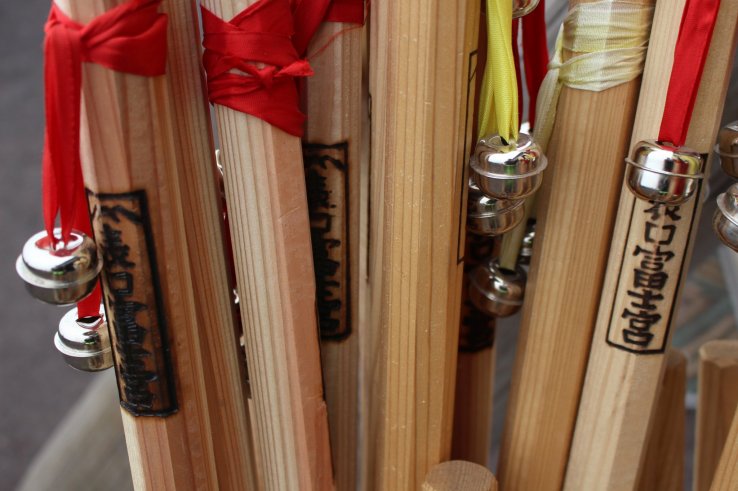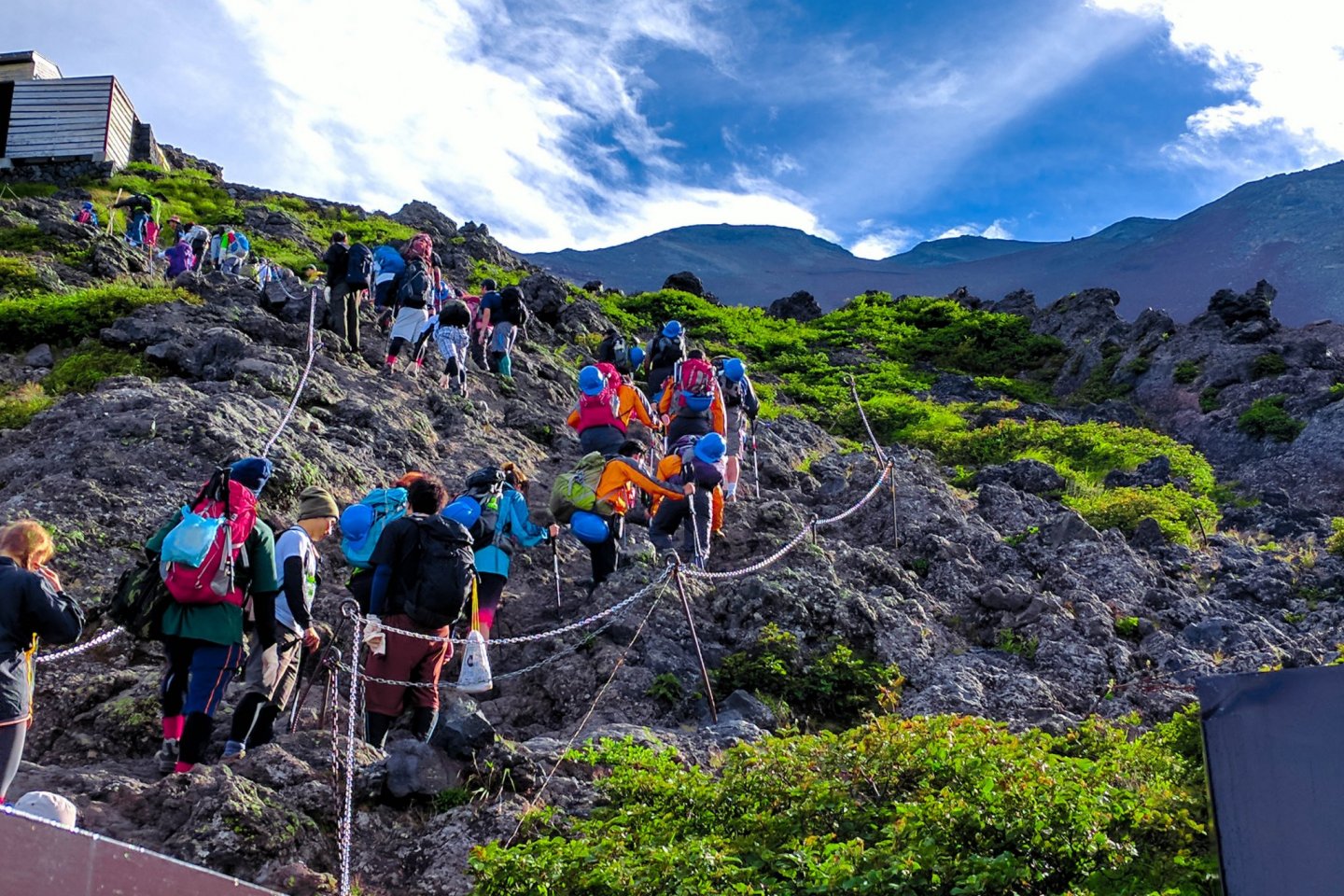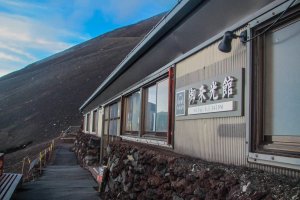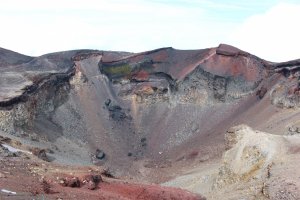Standing tall at 3,776 meters (12,389 feet), Mount Fuji is the highest peak in Japan and was designated as a UNESCO World Heritage Site in June 2013. It towers above the Japanese landscape and looms equally large in the Japanese consciousness, having appeared in innumerable works of art, story and song. For many, a view of Mt Fuji is a delight but a trek up to the mountain’s iconic peak is an unforgettable memory.

When to climb Mount Fuji?
Mt Fuji Climbing Season: Early June to September 10
During that time, visitors may freely use the trails that lead to the summit and the mountain huts and other services are open. One or two huts remain open through the end of September, but in general, services in the latter half of that month are severely curtailed.
As snow begins to settle on the upper reaches of the slopes in late September, the trails close completely. Only highly skilled mountaineers are permitted to climb the mountain in the offseason and, even then, those interested in a winter ascent MUST seek permission from the Yamanashi and Shizuoka prefectural governments and MUST be prepared for the treacherous, technical climb.
2025 Changes to Climbing Mount Fuji
In 2025, there are some changes to hiking Mount Fuji. Trailheads will be closed to day hikers from 2pm until 3am and reservation documents (for a mountain hut) will be needed for any climbs starting after 2pm. This is to prevent speedy 'bullet climbs' that has seen hikers taking insufficient rest or caution. A mandatory fee of 4,000 yen per person is required to climb, and it is separate from the mountain hut fee. The hiking fee also applies to anyone descending the Yoshida Trail, if ascending via another route. To manage crowds, an online reservation system with 3,000 daily slots available opens in April, but 1,000 slots will still be available for same-day visits.
Mount Fuji Trails
There are four trails that lead to the summit of Mt Fuji, and the entrance to each starts from the 5th station:
Yoshida Trail
The Yoshida Trail is the most popular route, and is the only trail that originates in Yamanashi Prefecture at an elevation of around 2300 meters. The trail’s starting point is known – somewhat confusingly – as the Fuji Subaru Line 5th station. It is here that most buses coming from Tokyo’s Shinjuku station will arrive and the 5th station provides a host of services to accommodate the numbers, from restaurants to toilets to shops selling gear, hiking sticks and canned oxygen. Higher up the mountain, the Yoshida Trail offers the largest concentration of huts between the 7th and 8th stations. As a bonus, the sunrise is best viewed from this side of the mountain’s rim.
Since 2025, Yoshida Trail has introduced a mandatory 4,000 yen entry fee per person for those who will pass through the gate at 5th station and a 4,000 daily hiker limit. An online reservation system allows booking from 3,000 daily slots in advance, but 1,000 slots will still be available for same-day visits. The hiking fee also applies to anyone descending the Yoshida Trail (payable at the 6th station), if ascending via another route.
You might like

Climbing Fuji: Yoshida Trail
Climbing Mt Fuji did not always go smoothly. Here are the mistakes I made so that you can learn from them.
Subashiri Trail
The Subashiri Trail begins on the eastern side of Mt Fuji in Shizuoka Prefecture, and its 5th station sits at a slightly lower elevation of 1970 meters. The Subashiri trail actually joins up with the Yoshida trail around the 8th station. Before that, the trail is relatively uncrowded. The 5th station provides little in the way of services compared to the Fuji Subaru 5th Station. Hikers who begin here will find toilets, two small restaurants/shops and a parking area. A highlight of this trail is the forest landscape hikers pass through early in the climb, before they emerge into the typical barren rocky landscape of the upper slopes.
Gotemba Trail
The Gotemba Trail begins on the southeastern side of the mountain, in Shizuoka Prefecture. With the 5th station here sitting only at 1440 meters above sea level, a hike to the summit from this starting point takes the longest of all the routes. The Gotemba 5th station is also one of the least developed of the four trails’ starting points, with only a small parking area, snack stall, and basic toilets. The trail also has relatively few huts along it, mostly between the 7th and 8th stations. This trail is perhaps most known for its lava-like landscape and a section known as the Osunabashiri, where hikers can almost surf down large sections of loose gravel during their descent.
Fujinomiya Trail
The Fujinomiya Trail is the southernmost of the four trails and the most accessible starting point for travelers coming from western Japan. It’s the second most developed of the four beginning stations and hikers here can expect a shop, a restaurant, toilets, ample parking and direct bus connections to stations along the Tokaido Shinkansen such as Mishima. With a starting elevation of 2380 meters above sea level, this is the shortest of the trails to the summit but the only one that offers zero visibility of a morning sunrise, until the final arrival at the mountain’s peak. About a half dozen huts are located along the route.
You might like

Fujinomiya Trail on Mount Fuji
Climbing Mount Fuji to the Seventh Station on the Fujinomiya Trail, where strong winds made us decide to turn back.
Planning your climb
Hiking Mt Fuji is a serious undertaking and should not be entered into lightly. With advance preparation, visitors will have a safe and enjoyable experience on Japan’s most inspiring peak.
Timing
While the climbing season for Mt Fuji extends over the course of two months, there are certain conditions to take into consideration when planning your hike.
In early July, the trail near the peak may still be covered in snow. Hikers at this time should be prepared for cold weather conditions on the summit and may want to bring crampons and sturdy winter-weather footwear.
During the August Obon holiday, the trail can become incredibly crowded, even on weekdays. Mountain huts are often booked to capacity and the large number of hikers that attempt the sunrise summit can make it very slow going along the latter sections of the trail.

Slightly less crowded times to plan a Mt Fuji hike include mid-July (before the start of school holidays in Japan) and late August to early September.
Another consideration for hikers is whether to spend the night on the mountain or attempt the summit in one day. A round-trip hike on the Yoshida Trail (the most popular) takes around 9-10 hours.

Some hikers prefer to arrive in late afternoon and spend the evening hours in a mountain hut, awakening around 2am or 3am for a final push to the top in time for sunrise. Other hikers prefer an early morning start, enjoying views from the summit around midday before descending for a late afternoon or early evening return back to nearby cities.
Weather consideration
Mt Fuji is so massive that the peak has its own identifiable weather pattern. There may even be a difference of up to 20 degrees Celsius from base to peak. While sunny skies may prevail at the 5th station, it’s smart to be prepared for cold, wet and even wintery conditions at the top.
Up to date forecasts can be checked on the Japanese Meteorological Agency webpage, which reports hourly on the conditions of Mt Fuji.
Booking a mountain hut
Those who choose to overnight on the mountain will need to reserve a place in one of the mountain huts along their chosen trail.

Hut reservations for the summer climbing season open on April 1st. As the space in huts is limited and hiking Mt Fuji is becoming increasingly popular, it is advisable to book as early as possible to avoid disappointment.
Most huts can be reserved by phone (in Japanese only). Some huts have English speakers on staff and a handful offer online booking in English.
While a credit card number may be requested to hold a reservation, all hut payments MUST be made in cash upon arrival.
A list of the huts on all four trails can be found on the official Mt Fuji climbing site.
Things you need
Hiking Mt Fuji is no walk in the park, but neither does it require much in the way of specialized gear.
It’s best to dress in layers to prepare for all potential weather conditions. Lower elevations may be warm at the hike’s start, but the summit can be brutally cold. Both sunscreen and winter hat and gloves should be packed.
In addition, day hikers will want to carry the following essentials:
- Comfortable backpack
- Bottles of water
- High energy snacks
- First aid kit (inc sunscreen)
- Small flashlight with extra batteries (for descents in the dark)
- A pair of sunglasses and/or a hat.

Night hikers will also need:
- Headlamp with spare batteries (essential for night hiking and preferable to a flashlight as it keeps your hands free)
- Consider additional warm layers for near the summit

What about money?
There are numerous vending machines and small huts selling drinks and food along certain routes.
Hikers may want to have ample small change for food and beverage purposes, as well as for the pay toilets that are found at higher elevations.
While there is no official admission fee to climb Mt Fuji, an official donation of 1,000 yen can be made at the trailheads, which goes towards safety and conservation. You'll get a small souvenir too for your generosity.
How much water?
It is best practice to at least carry some water with you (e.g. 500 ml x 2) with enough cash to buy more - you definitely want to stay hydrated during your expedition, but not to the extent you slow yourself down with excessive weight. Consider your fitness level and other factors like how hot it is expected to be.
Note that everything will be more expensive than you are used to at ground level, with bottles of water rising to 500 yen the further you climb.
Tips for novices
First-time climbers may feel both intimidated and exhilarated by a trek to the summit of Mt Fuji. The following pieces of advice from past hikers are good to keep in mind:
- Take it slow. Altitude sickness can strike anyone of any age or fitness level.
- Go at a slow, steady pace and allow your body to acclimate to the elevation, by resting at each station.
- Come equipped with a small, portable oxygen canister if you feel you might need it.
- If you become ill, do not be afraid or embarrassed to turn around the descend to a lower elevation.
- Be sure to check the weather before departing. Pack for ALL possible conditions. Layers are incredibly important.
- Wear sturdy shoes, preferably hiking shoes or sturdy sneakers. While some Japanese have climbed the mountain in flip flops, it’s best to be prepared to avoid potential injury.
- Buy a hiking stick and have a stamp burned onto it at each stage for a memorable souvenir of your climb.
- Pack a spare phone charger for sunrise photos. You don’t want to wake up and find your battery drained overnight at the hut.


Safety
Unlike certain regions of Japan, bears are of no concern to hikers on Mt Fuji, despite the prevalence of bear bells you may hear, attached to many Japanese hikers’ backpacks. Of greater concern is the potential for injury on the rocky uneven trails or the possibility of contracting altitude sickness.
Should you find yourself in a condition where you are unable to descend the mountain, it will be necessary to call emergency services. If you are on the Yoshida Trail, the point of contact is the Mount Fuji Conservation and Tourism Ecosystem Promotion Group Phone (055-223-1315). For those hiking through the Subashiri Trail, reach out to Shizuoka's Sports, Culture and Tourism Department, Mt. Fuji World Heritage Divison (054-221-3746). On the other trails, hikers in need are advised to call the police (110) or fire/ambulance services (119).
If the above options are impossible, seek help from the nearest mountain hut.
Getting to Mt Fuji
Yoshida Trail Access
During the climbing season, direct buses run from the Shinjuku Expressway Bus Terminal (next to Shinjuku Station) to the Fuji Subaru 5th Station, the starting point for the Yoshida Trail. The journey takes around 2.5 hours and costs ¥3800 (children are ¥1900). Tickets can be reserved at the highway bus website.
Subashiri Trail Access
Buses to the Subashiri 5th station run from Gotemba Station daily during the climbing season. During the remainder of the year, buses run on weekends only. The route takes around one hour and costs ¥2400. Buses run once an hour (usually on the :35) from 7:35 until 18:25 from the station to the trailhead. For the return journey, buses leave the 5th station (usually on the :45) from 8:45 to 19:45.
Gotemba Trail Access
Buses also run from Gotemba Station to the Gotemba trailhead, though not as frequently. There are six services a day, with the first one at 7:30am and the last at 16:05. In the opposite directions, six buses leave the trail daily for Gotemba station, beginning at 9:15am and ending at 17:45. The trip takes 30 minutes and costs ¥1130 one-way (or ¥1570 roundtrip).
Fujinomiya Trail Access
The Fujinomiya trailhead is the most easily reached from western Japan and buses leave for the mountain from the shinkansen stations at Mishima and Shin-Fuji. From Mishima Station (served by both the Kodama and a handful of Hikari shinkansen), the trip takes two hours and costs ¥3200, round trip. From Shin-Fuji Station, which is served only by the Kodama shinkansen, the trip to the trailhead takes 2.5 hours and costs ¥2740 (¥3700 roundtrip). Buses also bring visitors from Shizuoka and Fuji stations on the JR Tokaido line and Fujinomiya Station on the JR Minobu line.




































